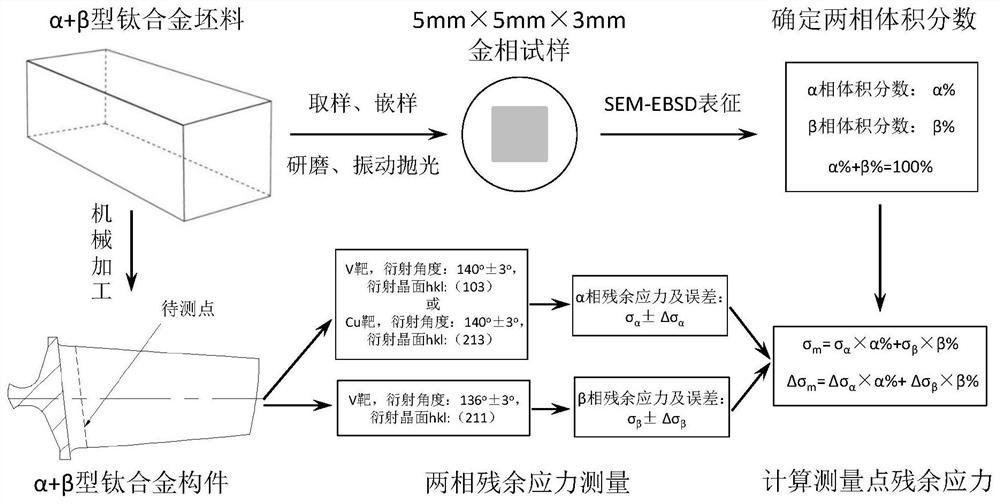A Calculation Method of X-ray Residual Stress of α+β Type Titanium Alloy
A technology of residual stress and titanium alloy, applied in force/torque/work measuring instruments, measuring force, measuring devices, etc., can solve problems such as inability to obtain true and reliable residual stress measurement results
- Summary
- Abstract
- Description
- Claims
- Application Information
AI Technical Summary
Problems solved by technology
Method used
Image
Examples
Embodiment 1
[0056] The TC17 titanium alloy blisk component used in an aero-engine has a nominal composition of Ti-5Al-2Sn-2Zr-4Mo-4Cr, and it is required to detect and evaluate the surface residual stress after machining.
[0057] In order to detect the residual stress at a measurement point of the TC17 titanium alloy blisk component, after the machining is completed, the following steps are carried out:
[0058] (1) Prepare a metallographic sample, the material taken is the same batch of blanks as the TC17 titanium alloy blisk component to be tested, and the size of the metallographic sample is 5mm×5mm×3mm;
[0059] (2) Embedding, grinding and vibrating polishing of metallographic samples;
[0060] (3) Scanning electron microscope-electron backscattering pattern technique (SEM-EBSD) is used to obtain the volume fraction of α phase in the metallographic sample: 27% and the volume fraction of β phase: 73%, 27%+73%=100 %,fulfil requirements;
[0061] (4) Place the TC17 titanium alloy blis...
Embodiment 2
[0073] A TC11 titanium alloy blade component used in an aero-engine has a nominal material composition of Ti-6.5Al-1.5Zr-3.5Mo-0.3Si. It is required to detect and evaluate the surface residual stress after the shot peening process is completed.
[0074] In order to detect the residual stress at a measurement point of the TC11 titanium alloy blade component, after the machining is completed, the following steps are carried out:
[0075] (1) Prepare a metallographic sample, the material taken is the same batch of blanks as the TC11 titanium alloy blade component to be tested, and the size of the metallographic sample is 5mm×5mm×3mm;
[0076] (2) Embedding, grinding and vibrating polishing of metallographic samples;
[0077] (3) Adopt scanning electron microscope-electron backscatter pattern technique (SEM-EBSD) to determine the volume fraction of α phase in the metallographic sample respectively: 68% and the volume fraction of β phase: 32%, 68%+32%=100 %,fulfil requirements;
...
Embodiment 3
[0090] A TC4 titanium alloy blade component used in an aero-engine has a nominal material composition of Ti-6Al-4V, and it is required to detect and evaluate the surface residual stress after the shot peening process is completed.
[0091] In order to detect the residual stress at a measurement point of the TC4 titanium alloy blade component, after the machining is completed, the following steps are carried out:
[0092] (1) Prepare a metallographic sample, the material taken is the same batch of blanks as the TC4 titanium alloy blade component to be tested, and the size of the metallographic sample is 5mm×5mm×3mm;
[0093] (2) Embedding, grinding and vibrating polishing of metallographic samples;
[0094] (3) Use scanning electron microscope-electron backscatter pattern technique (SEM-EBSD) to determine the volume fraction of α phase in the metallographic sample respectively: 40% and the volume fraction of β phase: 60%, 40%+60%=100 %,fulfil requirements;
[0095] (4) Place ...
PUM
 Login to View More
Login to View More Abstract
Description
Claims
Application Information
 Login to View More
Login to View More - R&D Engineer
- R&D Manager
- IP Professional
- Industry Leading Data Capabilities
- Powerful AI technology
- Patent DNA Extraction
Browse by: Latest US Patents, China's latest patents, Technical Efficacy Thesaurus, Application Domain, Technology Topic, Popular Technical Reports.
© 2024 PatSnap. All rights reserved.Legal|Privacy policy|Modern Slavery Act Transparency Statement|Sitemap|About US| Contact US: help@patsnap.com










